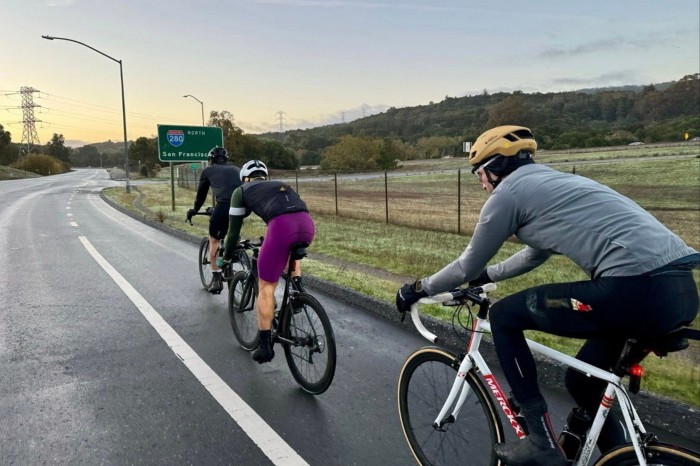Unlock Editors Digest for free
FT editor Roula Khalaf selects her favorite stories in this weekly newsletter.
Rain or shine, at 5.30am Clair Heaviside leaves his home in the Peak District, puts on a torch and gloves and runs the equivalent of a half marathon to his office in Manchester. The founder and creative director of digital marketing agency Serotonin leaves early four times a week, although sometimes he walks half the distance and the rest on the train. It depends on what training block I’m on. The important thing is that I always run.
In winter, Google DeepMind researcher Pablo Samuel Castro wakes up at 4:30 a.m., sometimes in -20C temperatures, and skis cross-country from Ottawa up to 40 minutes before board a train to Montreal. It stays in snow flattened by walkers. I can slide more and pick up some speed, he says. When there is not enough snow he tends to walk; in the summer he goes by bicycle.
Castro’s advantage is getting me in shape while listening to a podcast or mulling over a research problem. Heaviside says her morning run is part of her ultramarathon training and prepares her mentally and physically. After washing and changing, he has an hour or so of quiet work before anyone else enters.
Proponents of active commuting that combine a trip to work with physical activity extol the benefits not only for fitness, but also for mental health. A University of Edinburgh study this year found that cycling reduced mental health. Heaviside says running builds his resilience and determination, teaching him the importance of consistency over motivation.
Anthony Duggan, chairman of property group Knight Frank Europe, says he’s had some of his biggest breakthroughs thinking about work while cycling across London to the office. There are also cost savings and wider benefits such as reduced pollution and carbon emissions.
The pandemic boosted cycling as people sought socially distanced alternatives to public transport and exercise while sports centers were closed. One report found an 8% increase in cycling in 11 EU countries, although this was initially more for leisure than commuting as more people worked from home. Bicycle manufacturers around the world reported problems keeping up with demand. Cities introduced temporary bike lanes and imposed vehicle restrictions on some roads. A US study found that 32 of 42 major European cities and 102 of 200 American cities built or expanded bike lanes, with the majority appearing in New York (102 km), London (100 km), Montreal ( 88 km) and Paris (80 km).
Not everything lasted: a 2022 study by American academics found that 75% of the 487 measures were completed. Others spurred investment in infrastructure. These policies have become embroiled in culture wars, pitting cyclists against car owners. Post-pandemic trends are still emerging. In the UK, levels of cycling have declined since the peak of the pandemic. But the charity Cycling UK reports sustained growth in central London due to much better cycling infrastructure. Government figures show that the percentage of employed people who regularly cycled to work in central London was 7.1% in 2019, rising to 13.3% in 2021 and 11.2% the following year . Walking went from 11.5% to 16.1% between 2019 and 2022.
One barrier to running to work, says Simon Cook, a human geographer at Birmingham City University, is a lack of awareness. People simply don’t consider using an option to get around or see it as a means of transportation.

When he researched daily commutes before the pandemic, Cook found they were mostly committed runners and often middle-aged, urban-dwelling white men in high-paying professional jobs, with more than three-quarters covering between 3 and 8.99 miles Tasha Thompson, founder of London-based community group Black Girls Do Run, hopes that can change. Informal groups, fueled by pandemic membership, are doing a great job of energizing competitive clubs, and some members have started running for work. We have women running ultra distances now who never thought they would.
Thompson used to run regularly when her children were young, taking a precious window of time to cover the eight miles from the hospital where she was staying to her home in north-west London. I would have preferred to run in the morning, but there were no working showers. He once forgot to pack his running tights. I ran home in my dress and slippers.
Cook says good changing facilities encourage runners, although some manage to do so by using gym showers, running slowly to avoid sweating or just doing it one way at the end of their workday. . Typical preparation consists of limiting the load in a backpack, or planning a schedule that alternates with public transportation.
Duggan says his bike ride takes little planning, other than checking the weather and evening plans. It’s infinitely simpler now that I don’t have to wear a dress every day.
Not so for Heaviside, who takes a suitcase on the train to the office on Mondays that includes work clothes, laptop and make-up for the week. Packing is like setting the intention that helps me get in the mindset.
Will Swift, who cycled 12 miles along the south coast to the office four years ago, says he uses the journey to work to think about plans for the day and the journey home to reflect on his achievements. When I got home I was able to focus on my family life and felt much less stressed. For him, these benefits outweigh the punctures and the snow.
Employers can help active commuters with bike parks and programs that offer discounts on gear. There are many simple initiatives that workplaces can introduce, from encouraging walking meetings to having more flexible working to give employees with children time to take them to school, says Rachel Lee, director of policies of Living Streets, which campaigns for walking.
Alex Heatzigs’ Silicon Valley entrepreneur not only has a bike locker and showers, but a bus that can take him and his bike home after a 50-mile bike ride from his home in San Francisco to the Cupertino office. Between April and November before it gets cold, he makes the trip weekly with co-workers, sometimes covering 75 miles on a scenic route.
On any given week, we’ll have anywhere from four to 10 people, Heatzig says. It gives me an amazing way to create a community within my work, which is great for networking.
#Active #travelers #commuting #workout
Image Source : www.ft.com
